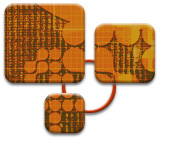|
 A
Teacher's Overview of the Site A
Teacher's Overview of the Site
The Maryland Faculty Online modules have been designed
by experienced faculty for faculty colleagues who will work on these
modules independently or as part of a structured faculty training program.
Each topic includes creative, interactive, useful, and motivational materials
and activities. A user should be able to complete a topic in approximately
30-50 minutes.
Levels Explained
The Maryland Faculty Online Training Topics have been designed to provide a
comprehensive training program for faculty at all levels:
Functions Explained
To successfully use the modules, you should know how to use the following functions:
Discussion Board
Resources: Found on
each Conclusion Page within each Module Topic, the Module authors have
provided a list of related Internet and print resources for the topic.
Guide Posts
Directed Tour:
- Introduction—provide a brief introduction
to the topic
- Learning Objectives—identify at least three
measurable learning objectives for the topic
- Content—provide a brief overview of the
topic
- Learning Activities—create at least two
interactive activities
- Check the Research—identify prior research
and its relation to the topic
- Resources for Reading and Research—list
at least three additional resources on the topic
- Assessment—create at least five quiz questions
relating to the topic (true-false, multiple choice)
- Glossary Terms—highlight and define within
content
- Ask Your Colleagues—provide or identify
a source of faculty audio or text based comments
- About the Author—provide a short bio of
your distance education experience and include photograph
Feedback
The Training Topics have at least four ways for participants to provide feedback:
1. Add Related Resources: By clicking on the Add Related
Resources link, users can fill in a form that asks them to recommend
related resources. Users will be asked to provide a title for the resource,
the URL or bibliographic reference, and a brief (3-5 sentences) description
of the resources and its usefulness.
2. Self-Assessments
3. Broken Links: Since the Maryland Faculty Online site
is extensive, users who discover a broken Internet link can report
these by simply clicking on the Broken Link button on the navigation
bar. The Broken Link button appears on most pages within the site.
4. Feedback Forms: The editors of Maryland Faculty Online
welcome user feedback to continuously improve the content and navigation
of the site. A Feedback Form is provided on the Crossing page for each
topic and on other strategic pages within the site.
Spotlight on Scenarios – Preparing
for Campus Training
1. Know Your Audience
The needs and time available of your faculty participants will influence the
length and depth of your training program. If you are training full time faculty
who are developing an entire online course, you may be able to schedule multiple
sessions during the work day. If you are training adjunct faculty who are teaching
an already-developed online course, you may not have to schedule fewer sessions
during the evening when adjunct faculty are typically available. For Continuing
Education faculty who can never come to campus for scheduled sessions, you
may want to use the topics as an online training program.
Experience of Instructors:
- New
- Intermediate
- Trainers
- Type of Faculty Position
- Full time Faculty
- Adjunct Faculty
- Continuing Education Faculty
2. Establish Your Purpose
Faculty training typically has two main purposes: to develop online courses
and to prepare for or improve online teaching.
Faculty who are developing a complete online course will
need a more lengthy training program that includes online pedagogy, using
your institution’s course management system (for example, Blackboard
or WebCT), and developing a personal web page. Faculty need the time
and resources to actually re-think and re-structure their course materials
and course organization. Plan on at least 20 hours of training and practice.
Faculty who are teaching online will not require as extensive
a training program, but they will need an introduction to online pedagogy,
lessons in how to use your institution’s course management system,
and time to develop a web page. If faculty are using materials provided
by the publisher, you may also be able to shorten the training time.
- Development
- Developing A Completely New Online Course
- Developing a New Course Using Publisher Materials
- Preparing To Teach Online
- Teaching An Already-Developed Online Course
- Extending Skills Of Experienced Online Faculty
3. How Much Time Do You Have
Weeks?_____ X Hours Per Week?______ = Total Training Hours_______
TOP
|